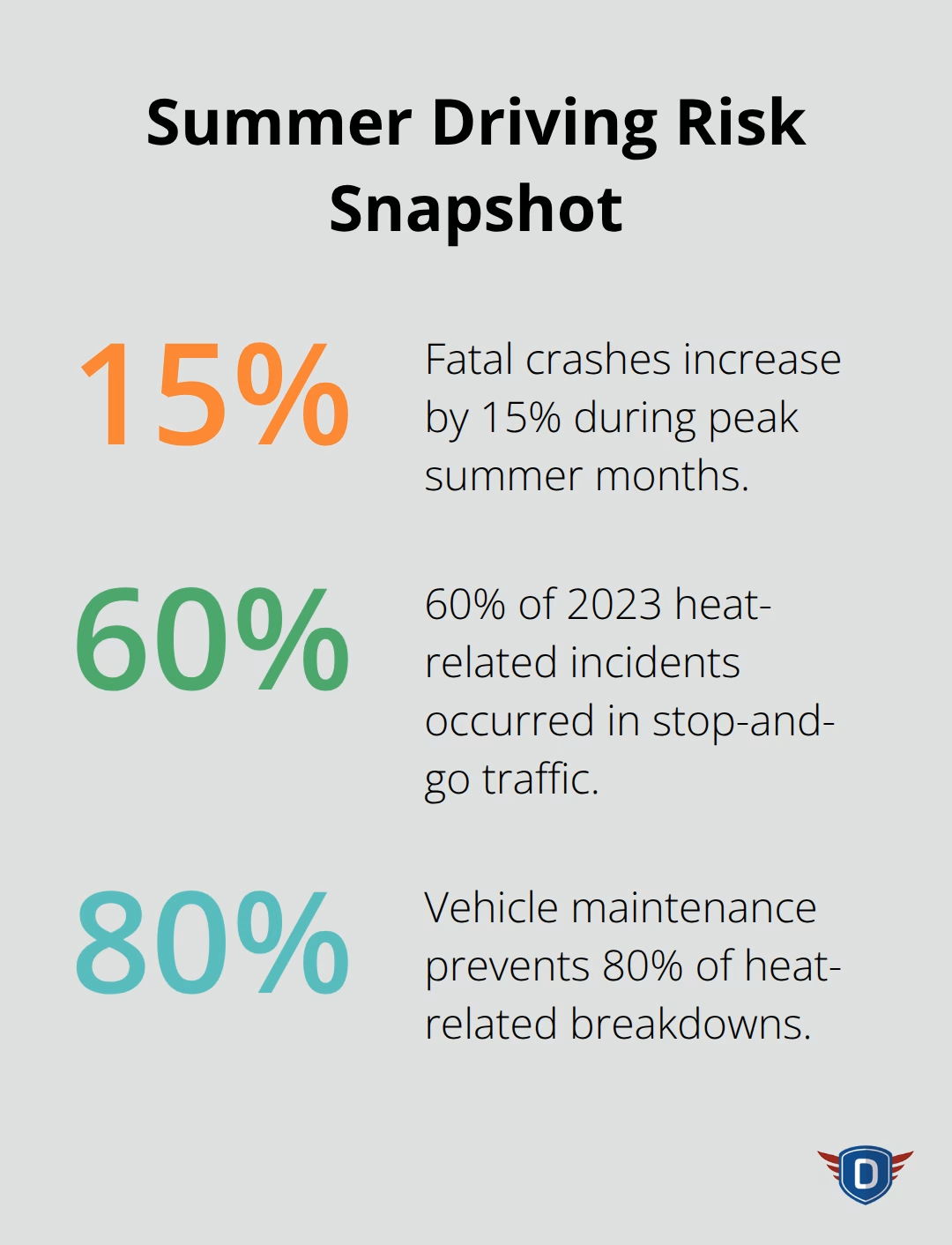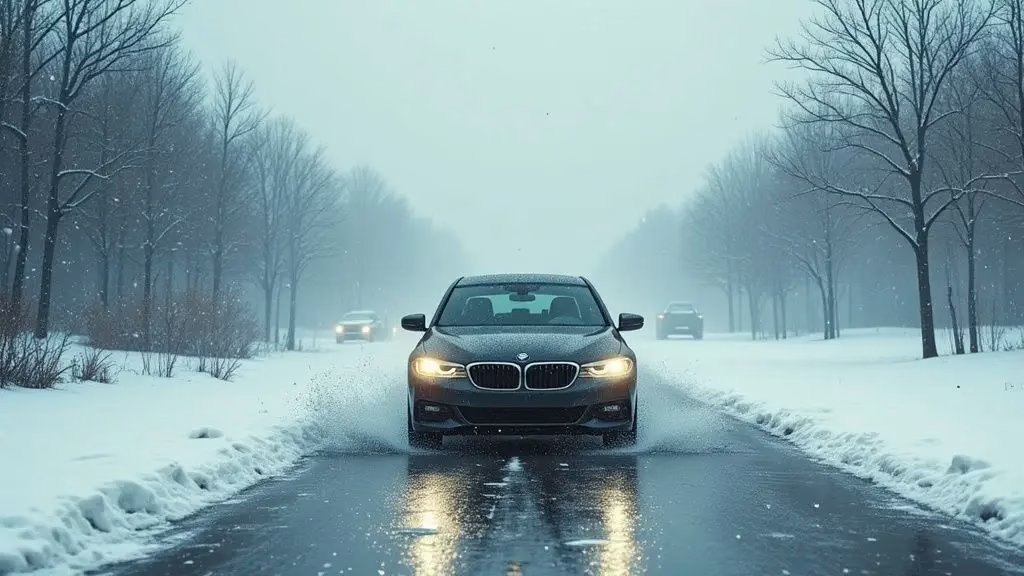Summer temperatures and vacation traffic create dangerous driving conditions that claim thousands of lives each year. The National Highway Traffic Safety Administration reports that fatal crashes increase by 15% during peak summer months.
We at floridadetscourse.com know that proper preparation and awareness can prevent most heat-related driving incidents. Summer safe driving requires both vehicle maintenance and smart driving strategies.
What Vehicle Checks Prevent Summer Breakdowns?
Your vehicle faces extreme stress during summer heat that can lead to dangerous roadside failures. The cooling system bears the heaviest burden, with potential for increased failures when temperatures exceed 90�F. Check coolant levels monthly and inspect hoses for cracks, bulges, or soft spots that indicate imminent failure. Replace any coolant that appears rusty or contains debris.

Cooling System Maintenance
Flush your cooling system every 30,000 miles or follow manufacturer specifications exactly. Use only the coolant type specified in your owner’s manual, as different formulations mix poorly and damage seals and gaskets. Test your radiator cap’s pressure annually, since a faulty cap allows coolant to boil at lower temperatures. Replace thermostat units that stick open or closed, as both conditions cause engine damage during hot weather.
Summer Tire Safety
Tire safety becomes critical during summer months when pavement temperatures reach 150�F. Check tire pressure when tires are cold, preferably before you drive in the morning. Tires lose 1-2 PSI for every 10-degree temperature increase, so adjust pressure accordingly. Inspect sidewalls for heat-related cracks, bulges, or worn tread below 4/32 inch depth. Replace tires that show any heat damage immediately, as summer conditions will worsen these defects rapidly.
Air Conditioning System Performance
Test your AC system before temperatures climb above 80�F, as repairs take longer during peak summer demand. Clean or replace cabin air filters every 12,000 miles to maintain airflow efficiency. Check refrigerant levels and have leaks repaired promptly, since low refrigerant forces your compressor to work harder and fail sooner. A properly functional AC system keeps you alert and prevents heat-related driver fatigue that contributes to thousands of summer accidents.
Battery and Electrical System Checks
Summer heat accelerates battery fluid evaporation and shortens battery life by up to 50% compared to moderate temperatures. Test your battery’s charge capacity before hot weather arrives (ideally when temperatures consistently exceed 85�F). Clean corrosion from battery terminals monthly and check that connections remain tight. Inspect alternator belts for cracks or fraying, as these components work overtime to power your AC system during summer months.
Once your vehicle passes these essential checks, you must prepare yourself to handle the physical and mental challenges that extreme heat creates for drivers.
How Do You Combat Heat Exhaustion Behind the Wheel?
Heat exhaustion strikes drivers faster than most people realize, with symptoms that appear when exposed to high temperatures. The American Automobile Association documented over 40,000 heat-related incidents in 2023, with 60% that occurred in stop-and-go traffic conditions. Watch for early warning signs: excessive sweat followed by sudden cessation of sweat, dizziness, nausea, or confusion. These symptoms impair reaction time and make lane changes extremely dangerous.

Stop Traffic Overheating Before It Starts
Stop-and-go traffic creates the worst conditions for both vehicle and driver overheating. Your engine temperature gauge will climb rapidly when air circulation drops below 15 mph for extended periods. Turn off your AC and roll down windows if your temperature gauge enters the red zone, then pull over safely within two minutes. Keep your engine running and rev gently to circulate coolant while you wait for temperatures to drop. Traffic jams that last over 20 minutes require mandatory breaks every 15 minutes to prevent heat stroke. Smart drivers monitor traffic apps and choose alternate routes when delays exceed 30 minutes during peak summer heat.
Hydration Strategy That Actually Works
Drink 8 ounces of water every hour while you drive in temperatures above 85�F, and start 30 minutes before you begin your trip. Research shows that dehydration affects concentration and driving performance. Avoid caffeine and alcohol, which accelerate dehydration and worsen heat exhaustion symptoms. Keep water bottles in insulated containers, as hot water from plastic bottles left in cars can cause stomach distress. Take mandatory 10-minute breaks every two hours in shaded areas, exit your vehicle completely, and consume electrolyte drinks if you sweat heavily.
Physical Warning Signs You Cannot Ignore
Heat stress affects your body in predictable stages that smart drivers learn to recognize early. Stage one brings excessive thirst and mild fatigue (often mistaken for normal tiredness). Stage two produces headaches, muscle cramps, and reduced urine output. Stage three creates confusion, rapid heartbeat, and loss of coordination that makes safe vehicle operation impossible. Monitor your physical state every 30 minutes during hot weather drives, and never dismiss early symptoms as minor discomfort. These breaks prevent the cumulative effects of heat exposure that lead to serious impairment behind the wheel.
Heavy vacation traffic presents additional challenges that require specific strategies to maintain safety when roads fill with unfamiliar drivers and aggressive behaviors increase.
How Do You Navigate Vacation Traffic Safely
Vacation traffic multiplies accident risks exponentially, with the Insurance Institute for Highway Safety reporting that summer and early fall are the most dangerous times of the year. Smart route planning prevents most dangerous situations before they develop. Leave between 4 AM and 6 AM or after 8 PM to avoid peak travel times when accident rates triple. Use real-time traffic apps like Waze or Google Maps that show construction zones and accident delays, then select alternate routes that add 15 minutes but eliminate stop-and-go conditions. Weekend departures on Friday after 2 PM create the worst traffic conditions, so shift travel to Thursday evening or Saturday morning instead.
Strategic Distance in Heavy Traffic
Increase your following distance to 5-6 seconds when traffic density exceeds normal conditions, as vacation drivers make unpredictable lane changes and sudden stops. The three-second rule fails completely in congested vacation traffic where reaction times must account for distracted drivers who check GPS devices or manage restless passengers. Position your vehicle in the right lane when possible, as left lanes experience more aggressive incidents. Watch for out-of-state license plates and rental vehicles, which indicate unfamiliar drivers who brake suddenly at exits or change lanes without proper signals.

Counter Aggressive Behavior Immediately
Road-rage shootings have surged by over 400% in recent years when drivers face delays and unfamiliar routes. Never engage with aggressive drivers through eye contact, gestures, or competitive behaviors that escalate dangerous situations. Move to the right lane and reduce speed when aggressive drivers tailgate or flash headlights behind you (typically 5-10 mph reduction works effectively). Call 911 immediately if aggressive drivers follow you for more than two exits or display weapons, and drive directly to the nearest police station rather than your destination. Keep doors locked and windows up when you confront aggressive behavior, as vacation stress creates unpredictable reactions from normally rational drivers.
Peak Travel Time Avoidance
Traffic volume data shows that Tuesday through Thursday departures reduce accident exposure compared to weekend travel. Monitor state transportation websites for construction schedules that affect major vacation routes, as summer road work creates bottlenecks that last for hours. Plan fuel stops every 200 miles rather than waiting for low fuel warnings (which often coincide with heavy traffic areas where gas stations become overcrowded). Download offline maps before departure to avoid cell service dead zones that force dangerous navigation decisions in unfamiliar territory.
Final Thoughts
Summer safe driving demands proactive preparation and constant vigilance throughout your journey. Vehicle maintenance prevents 80% of heat-related breakdowns, while driver awareness stops accidents before they happen. The combination of extreme temperatures and heavy vacation traffic creates conditions that test even experienced drivers.
Your cooling system, tires, and air conditioning require monthly inspections during summer months. Heat exhaustion symptoms appear faster than most drivers expect (making regular breaks and hydration non-negotiable safety practices). Vacation traffic brings unpredictable drivers and aggressive behaviors that require increased following distances and strategic route planning.
We at floridadetscourse.com teach defensive driving techniques that become automatic responses during stressful traffic situations. These skills prove invaluable when temperatures soar and patience runs thin on crowded highways. Start your summer travel preparation two weeks before departure, check every system, plan alternate routes, and commit to breaks every two hours regardless of schedule pressure.







